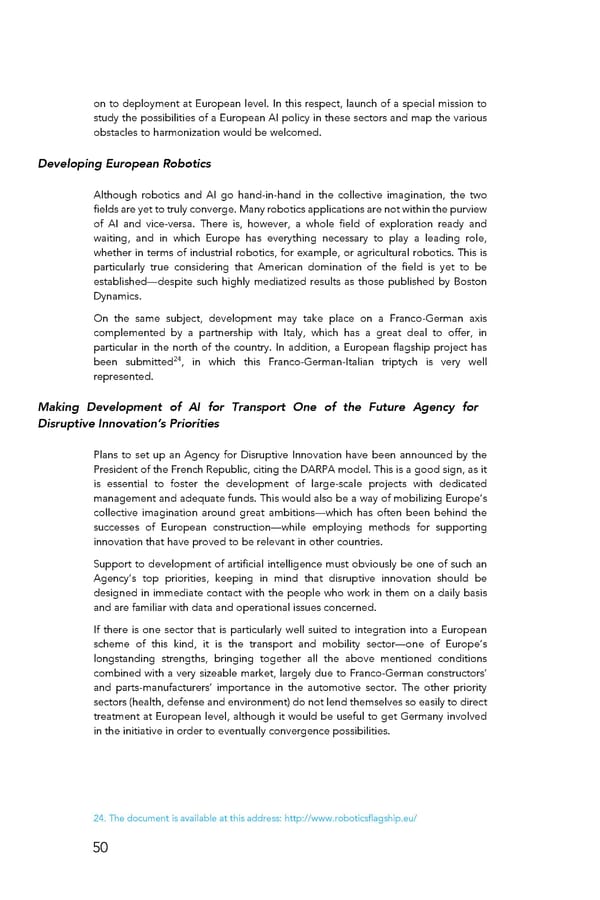on to deployment at European level. In this respect, launch of a special mission to study the possibilities of a European AI policy in these sectors and map the various obstacles to harmonization would be welcomed. Developing European Robotics Although robotics and AI go hand-in-hand in the collective imagination, the two fields are yet to truly converge. Many robotics applications are not within the purview of AI and vice-versa. There is, however, a whole field of exploration ready and waiting, and in which Europe has everything necessary to play a leading role, whether in terms of industrial robotics, for example, or agricultural robotics. This is particularly true considering that American domination of the field is yet to be established—despite such highly mediatized results as those published by Boston Dynamics. On the same subject, development may take place on a Franco-German axis complemented by a partnership with Italy, which has a great deal to offer, in particular in the north of the country. In addition, a European flagship project has 24 been submitted , in which this Franco-German-Italian triptych is very well represented. Making Development of AI for Transport One of the Future Agency for Disruptive Innovation’s Priorities Plans to set up an Agency for Disruptive Innovation have been announced by the President of the French Republic, citing the DARPA model. This is a good sign, as it is essential to foster the development of large-scale projects with dedicated management and adequate funds. This would also be a way of mobilizing Europe’s collective imagination around great ambitions—which has often been behind the successes of European construction—while employing methods for supporting innovation that have proved to be relevant in other countries. Support to development of artificial intelligence must obviously be one of such an Agency’s top priorities, keeping in mind that disruptive innovation should be designed in immediate contact with the people who work in them on a daily basis and are familiar with data and operational issues concerned. If there is one sector that is particularly well suited to integration into a European scheme of this kind, it is the transport and mobility sector—one of Europe’s longstanding strengths, bringing together all the above mentioned conditions combined with a very sizeable market, largely due to Franco-German constructors’ and parts-manufacturers’ importance in the automotive sector. The other priority sectors (health, defense and environment) do not lend themselves so easily to direct treatment at European level, although it would be useful to get Germany involved in the initiative in order to eventually convergence possibilities. 24. The document is available at this address: http://www.roboticsflagship.eu/ 50
 For a Meaningful AI - Report Page 50 Page 52
For a Meaningful AI - Report Page 50 Page 52